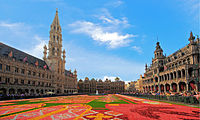
Photo from wikipedia
Breast tumor segmentation in ultrasound is important for breast ultrasound (BUS) quantitative analysis and clinical diagnosis. Even this topic has been studied for a long time, it is still a… Click to show full abstract
Breast tumor segmentation in ultrasound is important for breast ultrasound (BUS) quantitative analysis and clinical diagnosis. Even this topic has been studied for a long time, it is still a challenging task to segment tumor in BUS accurately arising from the difficulties of speckle noise and tissue background inconsistence. To overcome these difficulties, we formulate breast tumor segmentation as a classification problem in the neutrosophic set (NS) domain, which has been previously studied for removing speckle noise and enhancing contrast in BUS images. The similarity set score and homogeneity value for each pixel have been calculated in the NS domain to characterize each pixel of BUS image. Based on that, the seed regions are selected by an adaptive Otsu-based thresholding method and morphology operations, then an adaptive region growing approach is developed for obtaining candidate tumor regions in NS domain. The direction of region growing depends on the differences of similarity set score, texture homogeneity value, and distance value between the seed region and the candidate growing points. A deep convolutional neural network, based on VGG-16 network, is applied to each candidate tumor region for false positive reduction. A testing dataset with pathology proof includes 35 images without tumor, 36 images with benign tumors, and 50 images with malignant tumors. The numerical experiments show that the proposed method is effective to segment breast tumor in BUS images with average 81.6% and 84.4% percent dice coefficient, average 77.0% and 84.3% true positive ratio, average 11.2% and 15.2% false positive ratio, and average $57.5~pixels$ and $52.8~pixels$ Hausdorff distance for benign and malignant images, respectively.
Journal Title: IEEE Access
Year Published: 2019
Link to full text (if available)
Share on Social Media: Sign Up to like & get
recommendations!